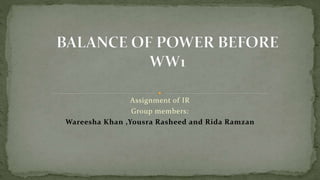
Balance of power before WW1.
- 1. Assignment of IR Group members: Wareesha Khan ,Yousra Rasheed and Rida Ramzan
- 2. 1. A distribution of military and economic power among nations that is sufficiently even keep any one of them from being too strong or dangerous 2. The power of a minority to give control to a larger group by allying with it 3. The balance of power theory in international relations suggests that national security is enhanced when military capability is distributed so that no one state is strong enough to dominate all others.
- 3. Unipolarity A single dominant state Example: United States after the end of cold war Bipolarity Two dominant states Example: U.S and Soviet Union during cold war Multipolarity Three or more states dominant the system. Example: the best example of multipolarity is world before WW1
- 4. Alliancesystem The alliance system was one of the main causes of World War One.The alliance system was made up of two groups, the Central powers (Germany, Austria- Hungary, Italy(1914), and Turkey).The second group was the Allied powers (Russia, France, Great Britain, and United states).
- 5. There were 6 big powers in Europe. There status as a powerful country depended on factors such as 1. The size of its overseas empire. 2. Its economy. 3. Its government structure. 4. Its leaders and its political situation. The size main powers were Germany, Britain, France, Austria-Hungary, Russia and Ottoman Empire.
- 6. GREAT BRITAIN "the empire on which the sun never sets"
- 8. 1. Great Britain was at the centre of the world’s largest empire, a beneficiary of colonial resources and trade. 2. Britain occupied territory on four different continents and was at the centre of a vast trading and commercial empire. 3. Domestically, 19th century Britain was often unsettled by demands for improved conditions and political reform. 4. British rulers engaged in imperial expansion but sought to avoid war, a policy dubbed ‘splendid isolation’. 5. This policy approached waned in the early 1900s, as British interest was sparked by events in Europe, particularly the unification of Germany and the expansionist policies adopted by Kaiser Wilhelm II.
- 9. Germany •Germany was had a huge effect on the balance of power . •Germany was controlled by the Kaiser Wilhelm the 2nd who held most of the power in a monarchy style government structure.
- 10. GERMAN ALLIANCES
- 11. The unification of the German Empire: Germany was made up of 39 states, including Prussia and Austria but in 1870 Otto von Bismarck united all 39 states to form a unified Germany. Germany as a unified country was a much more strong country . Germany's rising power alarmed Britain and Russia.
- 12. France France was once a very powerful country and was thought of as a threat to the peace in Europe up until 1870. it was Democratic but unstable. The economy in France between 1870 and 1914 was quite poor especially in comparison with Germany . Another big weakness in France was the military force which was not strong at all because it was untrained and disorganized.
- 13. The main fall of Frances balance of power in Europe was in 1871 when they fought in the Franco-Prussian war and were defeated badly by Germany.
- 14. Austria-Hungary
- 15. Weak country in comparison to other European countries. Poor economy and an unstable government structure. Had 2 monarchies (Austria and Hungary). There were 11 nationalities in Austria –Hungary. 15 different languages . 24% of the people living in Austria-Hungary were German. Had a poor military force also but had backing from countries such as Britain and France so it was not completely powerless. Very weak country during this period and did not really pose as a threat to many countries. Austria-Hungary